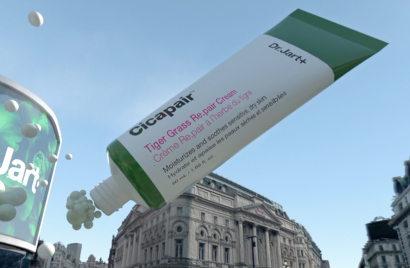
Dreamies investigation proves that the treats are irresistible to cats
The campaign by Adam&EveDDB concludes that the only cats who don’t love the pet treat are human Cats

The brand’s disruptive new AR-led campaign disrupts category norms and signals the rise of immersive digital experiences in ecommerce.

How do you solve a problem like delivering a multisensory high-performance product, at a time when consumers can’t physically touch, feel or smell beauty products? It’s a challenge tackled head on with art and creativity in Impero’s new AR-led campaign for skincare brand Dr Jart+, which disrupts the beauty category norms with a digital-first and experience-led approach to marketing.
A 360° film highlights the environmental and individual stressors facing consumers' skin, namely pollution and a lack of sleep. The two stressors are brought to life as 3D animations in a chaotic Piccadilly Circus. At the heart of the film is a 3D Cicapair Tiger, whose roar acts as the catalyst to shift the environment from chaos to calm. As the Tiger roars, Piccadilly Circus is transformed into a calming oasis, with Centella Asiatica plants, a key ingredient in the Cicapair range, growing all around and larger-than-life 3D Cicapair products soothing the environment and delivering calmness.
This highly visual and textual digital storytelling is given another layer of experience through an AR portal, which allows consumers and influencers to physically walk into the Cicapair world. The fusion of the physical and digital worlds had been a key trend in marketing prior to the pandemic and this campaign signals the growing importance of experience for brands seeking to capitalise on the rise of ecommerce.
Karen Ehrlich, Marketing and Consumer Engagement Director at Clinique and Dr Jart+ for UK and Ireland at The Estée Lauder Companies Inc, believes that, “brand websites will become more about brand experience than just ecommerce.”
It is a fundamental shift which is about more than any single execution or use of new technology such as Augmented Reality. As Michael Scantlebury, Director and Founder of Impero, explains: “What we are seeing is a move from brands simply broadcasting content out into the void towards more participation.” It’s a shift which he believes means brands need to do more to give consumers something playful.
“We always try to be very consumer centric,” adds Ehrlich. It’s a fact which means she approached the notion of digital-first with a genuine intent that transcends buzzwords. A genuine commitment, she explains, to asking, “How can we create something that is going to disrupt the market?”
“Every time you do something that is a first it's more complicated and we were learning as we went through the process,” she explained. “We had the confidence it was going to work, and we kept the consumer at the centre of the strategy at every point.”
Ehrlich explains that the campaign was underpinned by the brand’s commitment to the high efficacy of its products alongside its appreciation for art. “We wanted to do something disruptive. We know consumers are facing stress and a lack of sleep and we want our products to deliver results and address consumer needs. People want to know what is in the product, the ingredients, the results but we want to also deliver a really texturally rich sensory experience,” she adds.
Data from comparison platform Finder shows that the UK’s beauty industry was worth £27 billion in 2020, making it the seventh largest cosmetics market in the world. There is no question that the beauty category as a whole faces both disruption and opportunity as a result of the pandemic. While categories such as at-home hair dye kits have soared in lockdown, the cosmetics category as a whole has been hit by the impact of consumers staying at home and wearing masks. While the ‘lipstick effect’ is a well-known recession phenomenon, with consumers investing in ‘little treats’ to boost their moods, the combination of a strong lip and a face mask has shifted that dynamic considerably.
Skincare has replaced the lipstick lift as the category has been boosted by the growth of the ‘self-care’ focus amongst consumers spending more time at home. With physical stores closed consumers are naturally more reliant on online content to make their decisions. In 2020 Boots saw its online sales almost double and searches for skincare rose by 140% year on year.
“Consumers are looking for the delivery of efficacy,” explains Ehrlich. This is underpinned by the brand’s Korean innovation and technology. “We look at very specific consumer concerns and we know people are spending more time on their skincare and adding more products to their skincare routine,” she adds.
Yet while consumers are spending more time on their skincare and online, there are obvious limitations. “Digital is great but you can’t smell it or touch it,” explains Scantlebury. He says that the core question for the brand and agency alike was, how do you create a branded experience in lockdown? “We are in a state of perpetual boredom and this is a fun brand, a brand that is loved and we had an opportunity to be creative,” he says.
It’s well documented how the coronavirus crisis has accelerated the growth of ecommerce. Amidst this growth Scantlebury points to the ‘messy middle’ as the core challenge for brands. “Rather than thinking of the sales funnel we focused on being part of culture,” he adds.
Ehrlich explains: “When we look to the trends and the products which can meet this moment in time, it's about real-world brand experiences. But when we aren’t simply driving people to a physical store, we had to think harder about how we do it in a way that is different.”
She points to the importance of social platforms to meaningfully connect with consumers where they are. “For Gen Z and millennial consumers Tik Tok is a platform that can really show the product benefits,” she adds.
You don’t need to just look at your category, because your consumer exists in culture.
Michael Scantlebury
Notably, creating a digital brand experience that becomes part of culture demands embracing influencers, who form a core part of the campaign. It’s an approach that perhaps underlines the need for the industry to challenge outdated notions of influencers as ‘vacuous freeloaders’. “Influencers are easy targets,” explains Scantlebury. “When influencers get a bad rap its usually because a brand has done something silly.”
“There is a lot of algorithm-based ecommerce marketing in the market, but it's not binary. These things [influencer marketing, AR and SEO] work together.” Yet, Scantlebury is clear that the growth of ecommerce and the reality of a lockdown life lived online should not be mistaken for a unending appetite for branded content by consumers. “There is too much content,” he continues. “Too much to flick through on your phone. You need to be part of the story. That’s what is great about Tik Tok, it’s about being connected.”
That consumer-first attitude underpins Ehrlich’s approach. As she adds: “We saw consumer behaviour shift to online. We see this as an important part of how we sell but it’s all about capturing their attention and interest before we land that sales message.”
The scramble for direct-to-consumer routes and functioning ecommerce platforms was a reality for far too many brands at the start of the pandemic. Particularly when you consider just how long buzzwords such as ‘digital first’ and ‘digital transformation’ have topped the marketing agenda. For Dr Jart+ the brand benefited from the fact that it had defined itself as digital first for some time, a strategy reflected in its marketing skills and go to market strategies.
According to Ehrlich, this digital first outlook is broadening to encompass experiences. “The trend will continue and digital will continue to play a bigger role. There is a huge pressure on brands and retailers to create experiences,” she explains.
Then there is the rise of subscription platforms and services filling the void left by the ability to ‘try before you buy’ in traditional retail. “We outsource our decision making to subscriptions and algorithms. But the truth remains that to grab that attention you have to go old school. To drive cult status for a brand you have to do more,” explains Scantlebury.
For Ehrlich this shift will impact the brand's approach to ecommerce and its attitude towards direct-to-consumer marketing more broadly. It’s a shift that isn’t a response to headlines on the ‘death of the high street’ but more reflective of an omnichannel retail environment which serves consumers specific need states.
“There is always some pundit predicting the death of this, or the death of that. A lot of agencies are selling fear,” notes Scantlebury. Pointing to the huge influence of author Simon Sinek on the industry in dictating that all brands need a ‘Why’, he highlights the success of brand such as Red Bull which never had the hallowed 'why ' beyond its core product benefit: energy.
For Scantlebury, the magic happens when this brand benefit can be infused with fun and creativity, an approach which demands a broader view both of what you are trying to achieve and who you are trying to reach. “You don’t need to just look at your category, because your consumer exists in culture. What might seem weird inside a category, isn’t in culture,” he explains. It’s an approach that is placing the Dr Jart+ brand at the cutting edge of brand experience.


Looks like you need to create a Creativebrief account to perform this action.
Create account Sign inLooks like you need to create a Creativebrief account to perform this action.
Create account Sign in